Paper Menu >>
Journal Menu >>
 J. Service Science & Management, 2010, 3: 110-116 doi:10.4236/jssm.2010.31014 Published Online March 2010 (http://www.SciRP.org/journal/jssm) Copyright © 2010 SciRes JSSM Quantitative Assessment of Football Web Sites: An Empirical Study of the Best European Football Club Francisco Javier Miranda1, Antonio Cha morro2, Víctor Valero2, Jesús Maestre3 1Professor of Operation Management, University of Extremadura, Badajoz, Spain; 2Professor of Marketing, University of Extre- madura, Badajoz, Spain; 3Researcher, University of Extremadura, Badajoz, Spain. Email: fmiranda@unex.es Received October 1st, 2009; revised November 12th, 2009; accepted December 20th, 2009. ABSTRACT Football and the Internet have shown early signs of a prosperous marriage. Web sites with football content are among the most popular, with football followers and web users sharing remarkably similar demographics. Despite these com- pelling observations, limited empirical research has been undertaken exploring how to maximise the opportunities for competitive advantage that the Internet can provide to football clubs. This research was a response to this void, and was undertaken by manually accessing and evaluating the web sites of European Football Clubs. Quality of web sites was determined using an original Web Assessment Index, which focuses on four categories: accessibility, speed, navi- gability and content. A detailed report of the results arising from this investigatio n is presented and systematically ana- lyzed. These findings will be useful for both researchers and practitioners who seek to understand the issues relevant to football club management. Keywords: World Wide Web, Football, Content Analysis, Web Design, Internet, Research Paper 1. Introduction The number of Internet users has grown significantly over the last few years, from virtually nothing to an estimated 1.04 billion users that are 16% of the world’s population. This rapid growth in the number of Internet users has promoted a belief in many business circles that the Web represents a huge marketing opportunity. 1) With increasing interest in the Internet’s role for business marketing, sport marketers throughout the world and at all levels of the sport industry are rapidly working to incorporate emerging technologies into their marketing strategies. Not surprisingly, the Inter- net has become a significant marketing tool for many sport organisations, including professional sports teams. 2) The same market forces do not drive European Football Clubs websites as most other sectors. They have a loyal fan base that they can rely upon. They are able to provide a lot of exclusive content that can’t be found elsewhere. And they have brand names easily recognisable, in many cases, worldwide. Despite these apparent advantages, each club website should not be seen as operating in a vacuum. Whilst the temptation must be to consider that official club websites operate in an uncompetitive marketplace, there are authorita- tive and comprehensive websites from newspapers and TV channel and others, including “unofficial” fan websites, that provide alternatives for users to turn to. So, loyalty to one team should not be confused with loyalty to the team’s official website. The results of our survey should be considered within this broader context. Whilst the clubs doubtless enjoy large volumes of traffic, and many successful transactions, there is clear scope for improvement. European Clubs benefit from their high profile brands with regards to the large numbers of incoming links that boost their website’s visibility. Clubs will doubt- less be able to boast of large numbers of visits origi- nating from search engines. This appears to owe more to their brand name or unique offerings than to any clear evidence of optimisation on their sites. Yet, clubs should not feel that they should rely only on their suc- cessful brands. As good as this sector’s visibility is, there are still steps that could be taken by the majority of the clubs to improve that. And any improvement in visibility should ultimately result in increased revenue streams. This research evaluated the current practice of Euro- pean Football Clubs, assessing the effectiveness of their web sites. For this, we develop a web site assessment 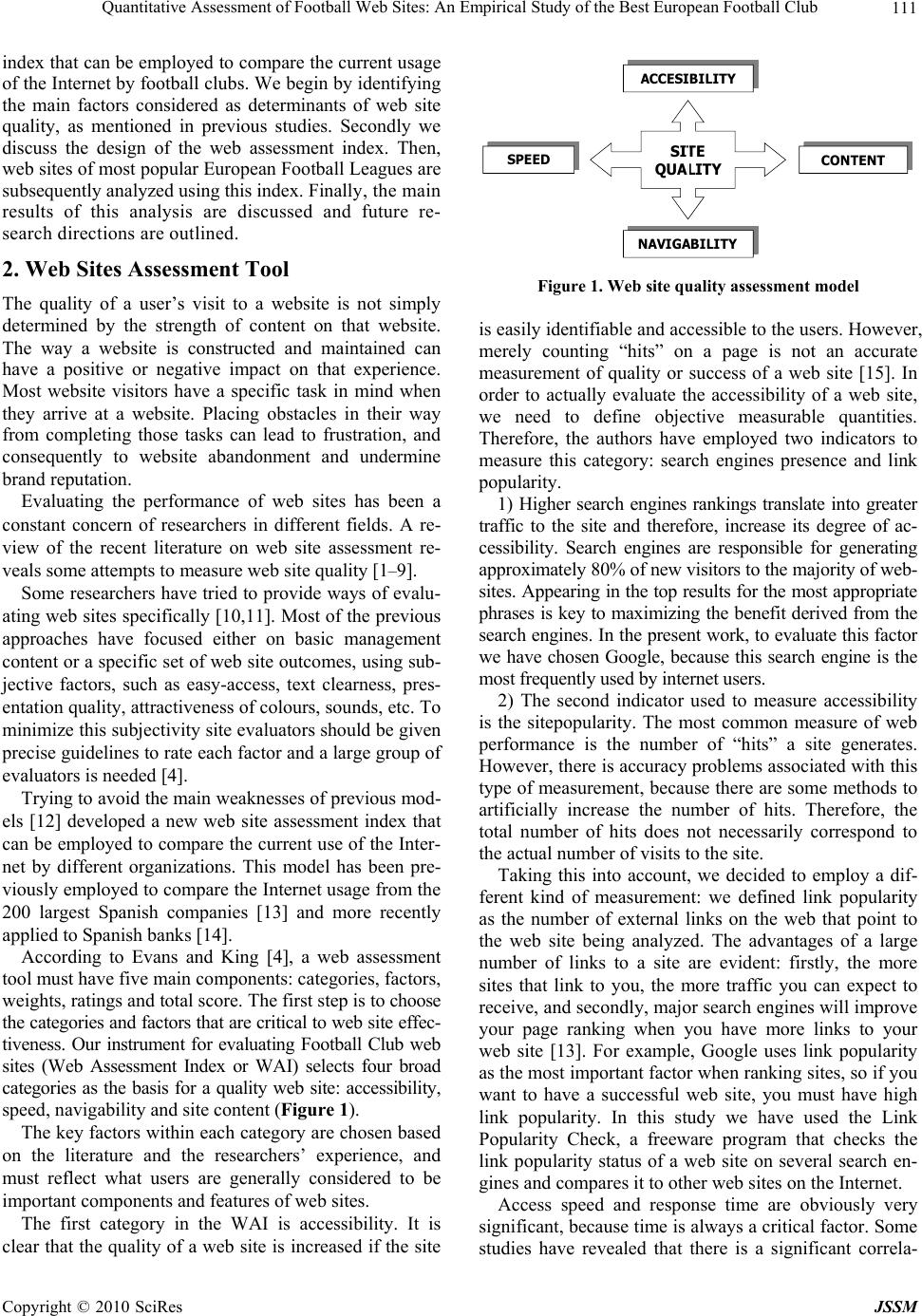 Quantitative Assessment of Football Web Sites: An Empirical Study of the Best European Football Club Copyright © 2010 SciRes JSSM 111 index that can be employed to compare the current usage of the Internet by football clubs. We begin by identifying the main factors considered as determinants of web site quality, as mentioned in previous studies. Secondly we discuss the design of the web assessment index. Then, web sites of most popular European Football Leagues are subsequently analyzed using this index. Finally, the main results of this analysis are discussed and future re- search directions are outlined. 2. Web Sites Assessment Tool The quality of a user’s visit to a website is not simply determined by the strength of content on that website. The way a website is constructed and maintained can have a positive or negative impact on that experience. Most website visitors have a specific task in mind when they arrive at a website. Placing obstacles in their way from completing those tasks can lead to frustration, and consequently to website abandonment and undermine brand reputation. Evaluating the performance of web sites has been a constant concern of researchers in different fields. A re- view of the recent literature on web site assessment re- veals some attempts to measure web site quality [1–9]. Some researchers have tried to provide ways of evalu- ating web sites specifically [10,11]. Most of the previous approaches have focused either on basic management content or a specific set of web site outcomes, using sub- jective factors, such as easy-access, text clearness, pres- entation quality, attractiven ess of colours, sound s, etc. To minimize this subjectivity site evaluators should be given precise guidelines to rate each factor and a large group of evaluators is needed [4]. Trying to avoid the main weaknesses of previous mod- els [12] developed a new web site assessment index that can be employed to compare the current use of the Inter- net by different organizations. This model has been pre- viously employed to compare the Internet usage from the 200 largest Spanish companies [13] and more recently applied to Spanish banks [14]. According to Evans and King [4], a web assessment tool must have five main components: categories, factors, weigh ts, ratings and total sc ore. The first step is to choose the categories and factors that are critical to web site effec- tiveness. Our instrument for evaluating Football Club web sites (Web Assessment Index or WAI) selects four broad categories as the basis for a quality web site: accessibility, speed, navigability and site content (Figure 1). The key factors within each category are chosen based on the literature and the researchers’ experience, and must reflect what users are generally considered to be important components and features of web sites. The first category in the WAI is accessibility. It is clear that the quality of a web site is increased if the site CONTENT ACCESIBILITY SPEED NAVIGABILITY SITE QUALITY Figure 1. Web site quality assessment model is easily identifiable and accessible to the users. However, merely counting “hits” on a page is not an accurate measurement of quality or success of a web site [15]. In order to actually evaluate the accessibility of a web site, we need to define objective measurable quantities. Therefore, the authors have employed two indicators to measure this category: search engines presence and link popularity. 1) Higher search engines rankings translate into greater traffic to the site and therefore, increase its degree of ac- cessibility. Search engines are responsible for generating approximately 80% of new visitors to the majority of web- sites. Appearing in the top results for the most app ropriate phrases is key to maximizing the benefit derived from the search engines. In the present wo rk, to evaluate this fa ctor we have chosen Google, because this search engine is the most frequently used by internet users. 2) The second indicator used to measure accessibility is the sitepopularity. The most common measure of web performance is the number of “hits” a site generates. However, there is accuracy problems associated with this type of measurement, because there are some methods to artificially increase the number of hits. Therefore, the total number of hits does not necessarily correspond to the actual number of visits to the site. Taking this into account, we decided to employ a dif- ferent kind of measurement: we defined link popularity as the number of external links on the web that point to the web site being analyzed. The advantages of a large number of links to a site are evident: firstly, the more sites that link to you, the more traffic you can expect to receive, and secondly, major search engines will improve your page ranking when you have more links to your web site [13]. For example, Google uses link popularity as the most important factor when ranking sites, so if you want to have a successful web site, you must have high link popularity. In this study we have used the Link Popularity Check, a freeware program that checks the link popularity status of a web site on several search en- gines and compares it to other web sites on the Internet. Access speed and response time are obviously very significant, because time is always a critical factor. Some studies have revealed that there is a significant correla- 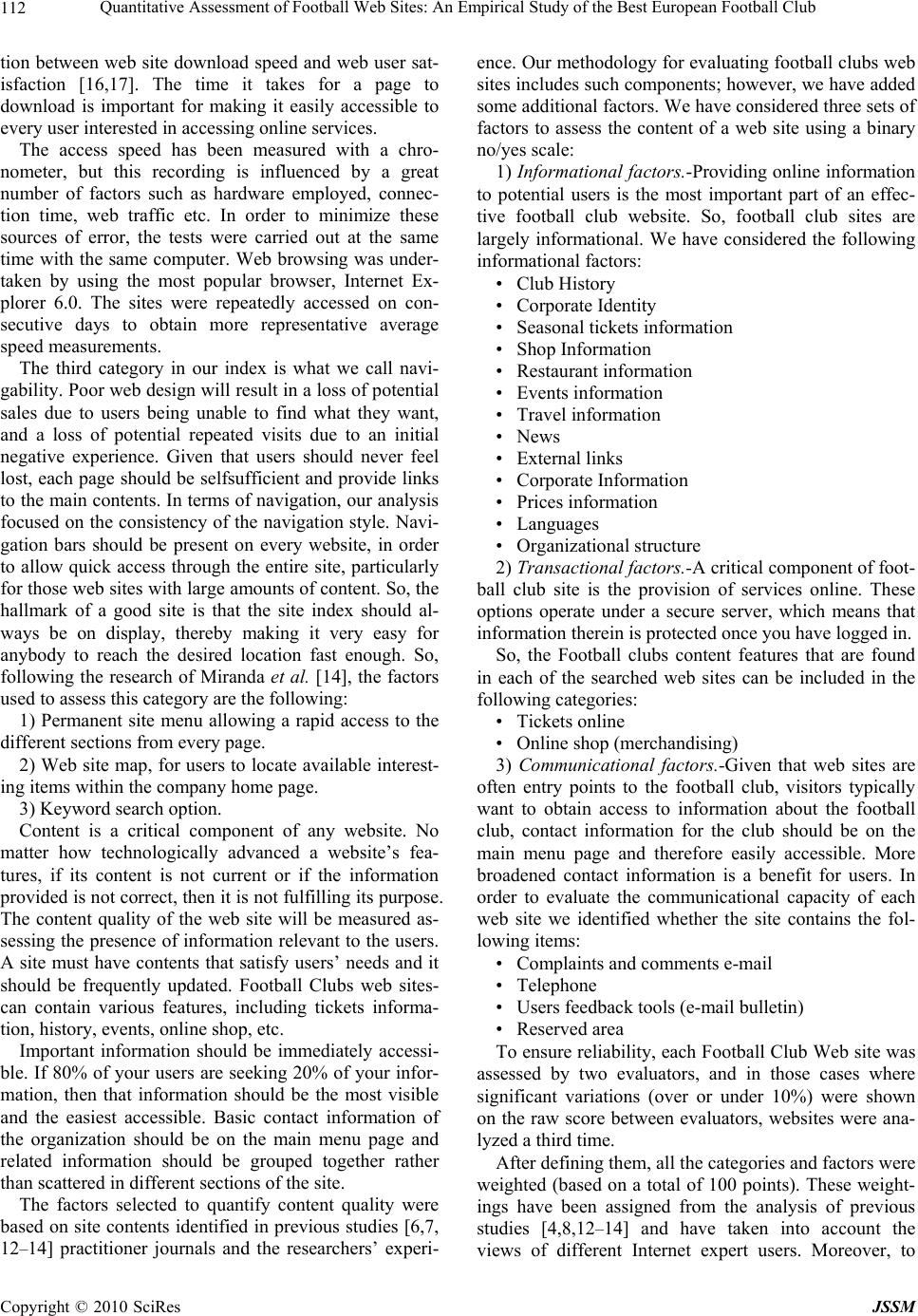 Quantitative Assessment of Football Web Sites: An Empirical Study of the Best European Football Club Copyright © 2010 SciRes JSSM 112 tion between web site download speed and web user sat- isfaction [16,17]. The time it takes for a page to download is important for making it easily accessible to every user interested in accessing online services. The access speed has been measured with a chro- nometer, but this recording is influenced by a great number of factors such as hardware employed, connec- tion time, web traffic etc. In order to minimize these sources of error, the tests were carried out at the same time with the same computer. Web browsing was under- taken by using the most popular browser, Internet Ex- plorer 6.0. The sites were repeatedly accessed on con- secutive days to obtain more representative average speed measurements. The third category in our index is what we call navi- gability. Poor web design will result in a loss of potential sales due to users being unable to find what they want, and a loss of potential repeated visits due to an initial negative experience. Given that users should never feel lost, each page should be selfsufficient and provide links to the main contents. In terms of navigation, our analysis focused on the consistency of the navigation style. Navi- gation bars should be present on every website, in order to allow quick access through the entire site, particularly for those web sites with large amounts of content. So, the hallmark of a good site is that the site index should al- ways be on display, thereby making it very easy for anybody to reach the desired location fast enough. So, following the research of Miranda et al. [14], the factors used to assess this category are the following: 1) Permanent site menu allowing a rapid access to the different sections from every page. 2) Web site map, for users to locate available interest- ing items within the company home page. 3) Keyword search option. Content is a critical component of any website. No matter how technologically advanced a website’s fea- tures, if its content is not current or if the information provided is not correct, then it is not fulfilling its purpose. The content quality of the web site will be measured as- sessing the presence of information relevant to the users. A site must have contents that satisfy users’ needs and it should be frequently updated. Football Clubs web sites- can contain various features, including tickets informa- tion, history, events, online shop, etc. Important information should be immediately accessi- ble. If 80% of your users are seeking 20% of your infor- mation, then that information should be the most visible and the easiest accessible. Basic contact information of the organization should be on the main menu page and related information should be grouped together rather than scattered in different sections of the site. The factors selected to quantify content quality were based on site contents identified in previous studies [6,7, 12–14] practitioner journals and the researchers’ experi- ence. Our methodology for evaluating football clubs web sites includes such components; however, we have added some additional factors. We have considered three sets of factors to assess the content of a web site using a binary no/yes scale: 1) Informational facto rs.-Providing online information to potential users is the most important part of an effec- tive football club website. So, football club sites are largely informational. We have considered the following informational factors: • Club History • Corporate Identity • Seasonal tickets information • Shop Information • Restaurant information • Events information • Travel information • News • External links • Corporate Information • Prices information • Languages • Organizational structure 2) Transactional factors.-A critical component of foot- ball club site is the provision of services online. These options operate under a secure server, which means that information therein is protected once you have logged in. So, the Football clubs content features that are found in each of the searched web sites can be included in the following categories: • Tickets online • Online shop (merchandising) 3) Communicational factors.-Given that web sites are often entry points to the football club, visitors typically want to obtain access to information about the football club, contact information for the club should be on the main menu page and therefore easily accessible. More broadened contact information is a benefit for users. In order to evaluate the communicational capacity of each web site we identified whether the site contains the fol- lowing items: • Complaints and comments e-mail • Telephone • Users feedback tools (e-mail bulletin) • Reserved area To ensure reliability, each Football Club Web site was assessed by two evaluators, and in those cases where significant variations (over or under 10%) were shown on the raw score between evaluators, websites were ana- lyzed a third time. After defining them, all the categories and factors were weighted (based on a total of 100 points). These weight- ings have been assigned from the analysis of previous studies [4,8,12–14] and have taken into account the views of different Internet expert users. Moreover, to 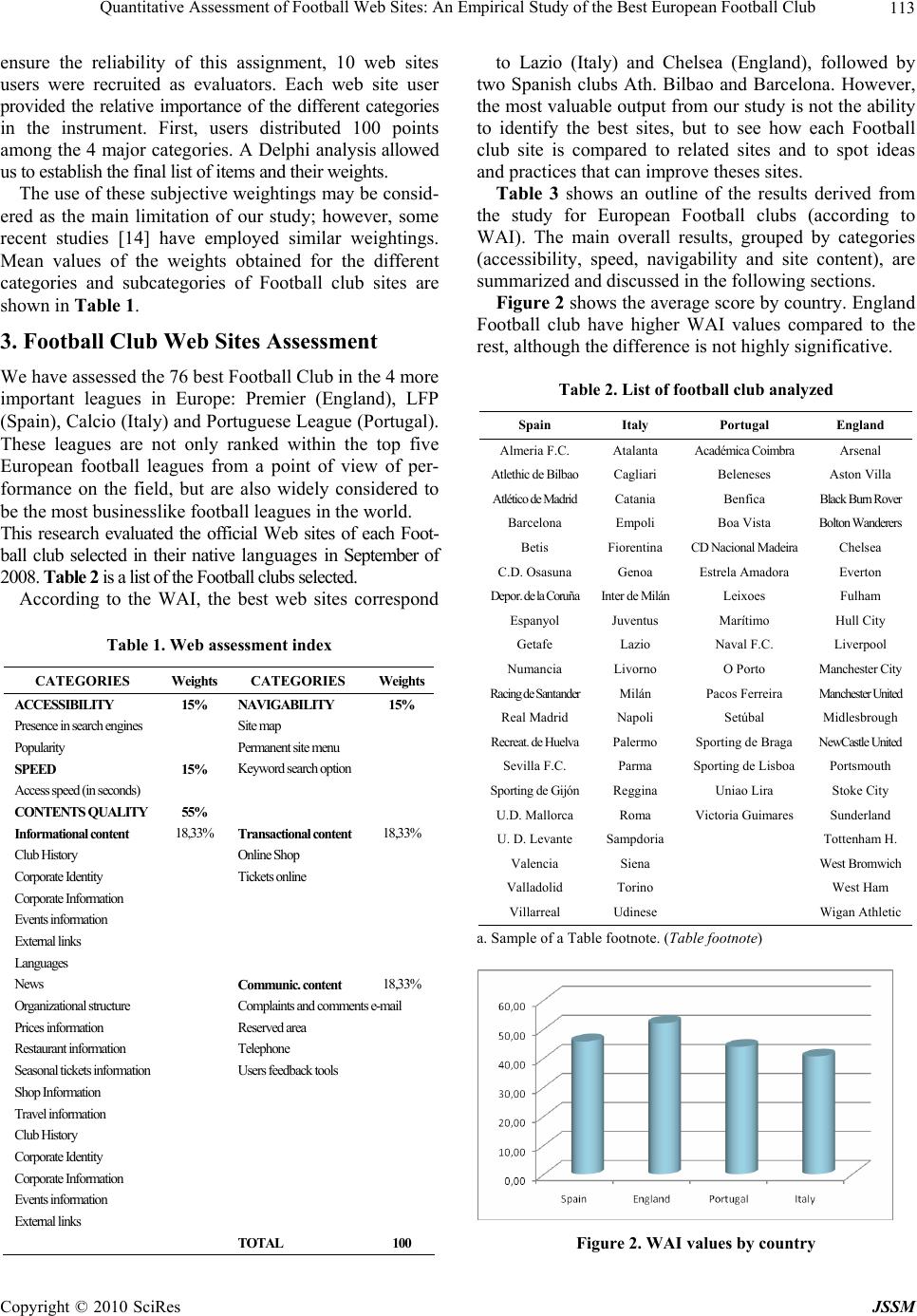 Quantitative Assessment of Football Web Sites: An Empirical Study of the Best European Football Club Copyright © 2010 SciRes JSSM 113 ensure the reliability of this assignment, 10 web sites users were recruited as evaluators. Each web site user provided the relative importance of the different categories in the instrument. First, users distributed 100 points among the 4 major categories. A Delphi analysis allowed us to e sta bli sh t he fi nal lis t of it ems a nd t heir wei ght s. The use of these subjective weightings may be consid- ered as the main limitation of our study; however, some recent studies [14] have employed similar weightings. Mean values of the weights obtained for the different categories and subcategories of Football club sites are shown in Table 1. 3. Football Club Web Sites Assessment We have assessed the 76 best Football Club in the 4 more important leagues in Europe: Premier (England), LFP (Spain), Calcio (Italy) and Portuguese League (Portugal). These leagues are not only ranked within the top five European football leagues from a point of view of per- formance on the field, but are also widely considered to be the most businesslike football leagues in the world. This research evaluated the official Web sites of each Foot- ball club selected in their native languages in September of 2008. Table 2 is a list of the Football clubs selected. According to the WAI, the best web sites correspond Table 1. Web assessment index CATEGORIES Weights CATEGORIES Weights ACCESSIBILITY 15% NAVIGABILITY 15% Presence in search engines Site map Popularity Permanent site menu SPEED 15% Keyword search option Access speed (in seconds) CONTENTS QUALITY 55% Informational content 18,33% Transactional content 18,33% Club History Online Shop Corporate Identity Tickets online Corporate Information Events information External links Languages News Communic. content 18,33% Organiz ational str ucture Complai nts and comm ents e-mail Prices information Reserved area Restaurant information Telephone Seasonal tickets information Users feedback tools Shop Information Travel information Club History Corporate Identity Corporate Information Events information External links TOTAL 100 to Lazio (Italy) and Chelsea (England), followed by two Spanish clubs Ath. Bilbao and Barcelona. However, the most valuable outpu t from our study is not the ab ility to identify the best sites, but to see how each Football club site is compared to related sites and to spot ideas and practices that can improve theses sites. Table 3 shows an outline of the results derived from the study for European Football clubs (according to WAI). The main overall results, grouped by categories (accessibility, speed, navigability and site content), are summarized and discussed in the following sections. Figure 2 shows the aver age scor e by country. Englan d Football club have higher WAI values compared to the rest, although the difference is not highly significative. Table 2. List of football club analyzed Spain Italy Portugal England Almeria F.C. Atalanta Académica Coimbra Arsenal Atlethic de Bil bao Cagliari Beleneses Aston Villa Atlético de Madrid Catania Benfica Black Burn Rover Barcelona Empoli Boa Vista Bolton Wanderers Betis Fiorentina C D N ac i o n a l M a d e i ra Chelsea C.D. Osasuna Genoa Estrela Amadora Everton Depor. d e la Cor uña Inter de Milán Leixoes Fulham Espanyol Juventus Marítimo Hull City Getafe Lazio Naval F.C. Liverpool Numancia Livorno O Porto Manchester City Racing de Santander Milán Pacos Ferreira Manchester United Real Madrid Napoli Setúbal Midlesbr ough Recreat. de Huelva Palermo Sporting de Braga NewC ast le Uni ted Sevilla F.C. Parma Sporting de Lisboa Portsmouth Sporting d e GijónReggina Uniao Lira Stoke City U.D. Mallorca Roma Victoria Guimares Sunderland U. D. Levante Sampdoria Tottenham H. Valencia Siena West Bromwich Valladolid Torino West Ham Villarreal Udinese Wigan Athletic a. Sample of a Table footnote. (Table footnote) Figure 2. WAI values by country 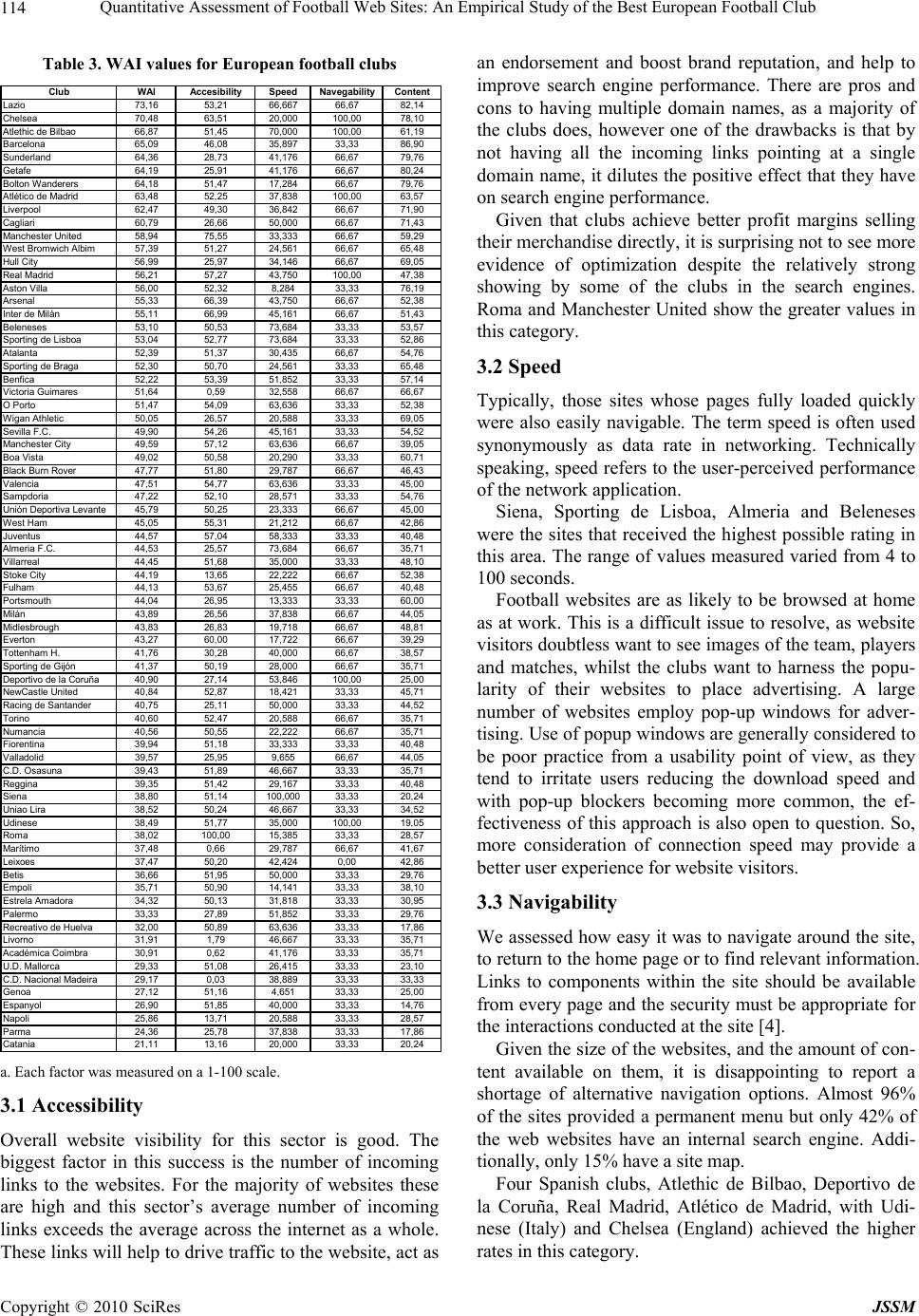 Quantitative Assessment of Football Web Sites: An Empirical Study of the Best European Football Club Copyright © 2010 SciRes JSSM 114 Table 3. WAI values for European football clubs ClubWAIAccesibilitySpeedNavegability Content Lazio73,1653,2166,667 66,6782,14 Chelsea70,4863,5120,000 100,0078,10 Atl ethic de B i lbao66,8751, 4570,0001 00 , 0 061,19 Barcelona65,0946,0835,897 33,3386,90 Sunderland64,3628,7341,176 66,6779,76 Getafe64,1925,9141,176 66,6780,24 Bolton Wanderers64,1851,4717,28466,6779,76 Atlético de Madrid63,4852,2537,838100,0063,57 Liverpool62,4749,3036,842 66,6771,90 Cagliari60,7926,6650,000 66,6771,43 Manchester United58,9475,5533,33366,6759,29 West Bromwich Albim57,3951,2724,56166,6765,48 Hull City56,9925,9734,14666,6769,05 Real Madrid56,2157,2743,750100,0047,38 Aston Villa56,0052,328,28433,3376,19 Arsenal55,3366,3943,750 66,6752,38 Inter de Milán55,1166,9945,16166,6751,43 Beleneses53,1050,5373,684 33,3353,57 Sporting de Lisboa53,0452,7773,68433,3352,86 Atalanta52,3951,3730,435 66,6754,76 Sporting de Braga52,3050,7024,56133,3365,48 Benfica52,2253,3951,852 33,3357,14 Victoria Guimares51,640,5932,55866,6766,67 O Porto51,4754,0963,63633,3352,38 Wigan Athletic50,0526,5720,58833,3369,05 Sevilla F.C.49,9054,2645,16133,3354,52 Manchester City49,5957,1263,63666,6739,05 Boa Vista49,0250,5820,29033,3360,71 Black Burn Rover47,7751,8029,78766,6746,43 Valencia47,5154,7763,636 33,3345,00 Sampdoria47,2252,1028,571 33,3354,76 Unión Deportiva Levante45,7950,2523,33366,6745,00 West Ham45,0555,3121,21266,6742,86 Juventus44,5757,0458,333 33,3340,48 Almeria F.C.44,5325,5773,68466,6735,71 Villarreal44,4551,6835,000 33,3348,10 Stoke City44,1913,6522,22266,6752,38 Fulham44,1353,6725,455 66,6740,48 Portsmouth44,0426,9513,333 33,3360,00 Milán43,8926,5637,838 66,6744,05 Midlesbrough43,8326,8319,718 66,6748,81 Everton43,2760,0017,722 66,6739,29 Tottenham H.41,7630,2840,00066,6738,57 Sporting de Gijón41,3750,1928,00066,6735,71 Deportivo de la Coruña40,9027,1453,846100,0025,00 NewCastle United40,8452,8718,42133,3345,71 Racing de Santander40,7525,1150,00033,3344,52 Torino40,6052,4720,588 66,6735,71 Numancia40,5650,5522,222 66,6735,71 Fiorentina39,9451,1833,333 33,3340,48 Valladolid39,5725,959,655 66,6744,05 C.D. Osasuna39,4351,8946,66733,3335,71 Reggina39,3551,4229,167 33,3340,48 Siena38,8051,14100,000 33,3320,24 Uniao Lira38,5250,2446,66733,3334,52 Udinese38,4951,7735,000 100,0019,05 Roma38,02100,0015,385 33,3328,57 Marítimo37,480,6629,787 66,6741,67 Leixoes37,4750,2042,4240,0042,86 Betis36,6651,9550,000 33,3329,76 Empoli35,7150,9014,141 33,3338,10 Estrela Amadora34,3250,1331,81833,3330,95 Palermo33,3327,8951,852 33,3329,76 Recreativo de Huelva32,0050,8963,63633,3317,86 Livorno31,911,7946,667 33,3335,71 Académica Coimbra30,910,6241,17633,3335,71 U.D. Mallorca29,3351,0826,41533,3323,10 C.D. Nacional Madeira29,170,0338,88933,3333,33 Genoa27,1251,164,651 33,3325,00 Espanyol26,9051,8540,000 33,3314,76 Napoli25,8613,7120,588 33,3328,57 Parma24,3625,7837,838 33,3317,86 Catania21,1113,1620,000 33,3320,24 a. Each factor was measured on a 1-100 scale. 3.1 Accessibility Overall website visibility for this sector is good. The biggest factor in this success is the number of incoming links to the websites. For the majority of websites these are high and this sector’s average number of incoming links exceeds the average across the internet as a whole. These links will help to drive traffic to the website, act as an endorsement and boost brand reputation, and help to improve search engine performance. There are pros and cons to having multiple domain names, as a majority of the clubs does, however one of the drawbacks is that by not having all the incoming links pointing at a single domain name, it dilutes the positive effect that they have on search engine performance. Given that clubs achieve better profit margins selling their merchandise directly, it is surprising not to see more evidence of optimization despite the relatively strong showing by some of the clubs in the search engines. Roma and Manchester United show the greater values in this category. 3.2 Speed Typically, those sites whose pages fully loaded quickly were also easily navigable. The term speed is often used synonymously as data rate in networking. Technically speaking, speed refers to the user-perceived performance of the netw ork application. Siena, Sporting de Lisboa, Almeria and Beleneses were the sites that received the highest possible rating in this area. The range of values measured varied from 4 to 100 seconds. Football websites are as likely to be browsed at home as at work. This is a difficult issue to resolve, as website visitors doubtless want to see images of the team, players and matches, whilst the clubs want to harness the popu- larity of their websites to place advertising. A large number of websites employ pop-up windows for adver- tising. Use of popup w indows ar e gene rally co n sidered to be poor practice from a usability point of view, as they tend to irritate users reducing the download speed and with pop-up blockers becoming more common, the ef- fectiveness of this approach is also open to question. So, more consideration of connection speed may provide a better user experience for we bsite visitors. 3.3 Navigability We assessed how easy it was to navigate around the site, to return to th e home p age or to find relevant information. Links to components within the site should be available from every page and the security must be appropriate for the interactions conducted at the site [4]. Given the size of the websites, and the amount of con- tent available on them, it is disappointing to report a shortage of alternative navigation options. Almost 96% of the sites provided a permanent menu but only 42% of the web websites have an internal search engine. Addi- tionally, only 15% have a site map. Four Spanish clubs, Atlethic de Bilbao, Deportivo de la Coruña, Real Madrid, Atlético de Madrid, with Udi- nese (Italy) and Chelsea (England) achieved the higher rates in this category. 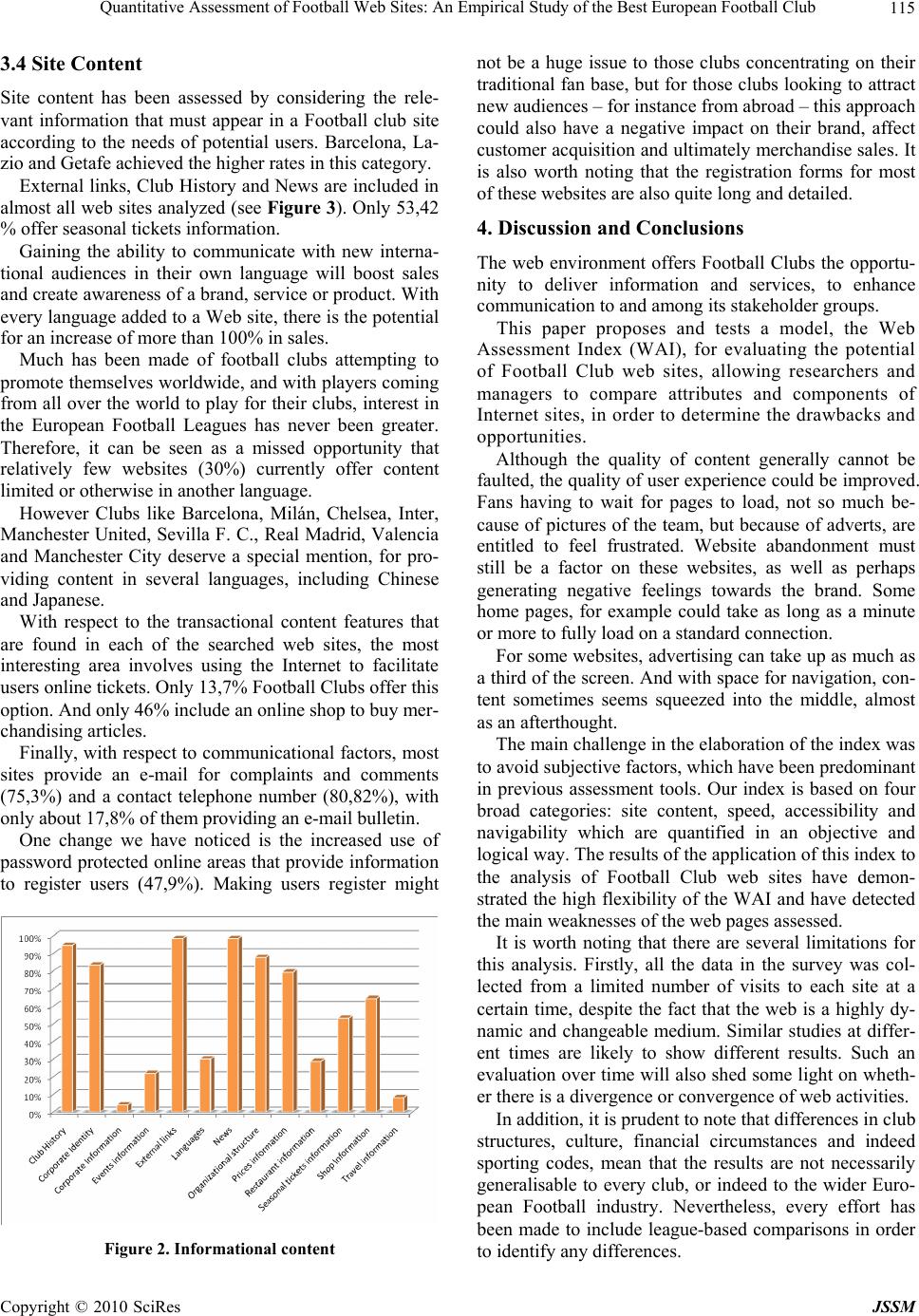 Quantitative Assessment of Football Web Sites: An Empirical Study of the Best European Football Club Copyright © 2010 SciRes JSSM 115 3.4 Site Content Site content has been assessed by considering the rele- vant information that must appear in a Football club site according to the needs of potential users. Barcelona, La- zio and Geta fe achieved the high er rates in this category. External links, Club History and News are included in almost all web sites analyzed (see Figure 3). Only 53,42 % offer seasonal tickets information. Gaining the ability to communicate with new interna- tional audiences in their own language will boost sales and create awareness of a brand, service or product. With every language added to a Web site, there is the poten tial for an increase of more than 100% in sales. Much has been made of football clubs attempting to promote themselves worldwide, and with players coming from all over the world to play for their clubs, interest in the European Football Leagues has never been greater. Therefore, it can be seen as a missed opportunity that relatively few websites (30%) currently offer content limited or otherwise in another language. However Clubs like Barcelona, Milán, Chelsea, Inter, Manchester United, Sev illa F. C., Real Madrid, Valencia and Manchester City deserve a special mention, for pro- viding content in several languages, including Chinese and Japanese. With respect to the transactional content features that are found in each of the searched web sites, the most interesting area involves using the Internet to facilitate users online ticke ts. Only 13,7% Fo o tball Club s offer this option. And only 4 6% include an online shop to buy mer- chandising articles. Finally, with respect to communicatio nal factors, most sites provide an e-mail for complaints and comments (75,3%) and a contact telephone number (80,82%), with only about 17,8% of them providing an e-mail bulletin. One change we have noticed is the increased use of password protected online areas th at provide information to register users (47,9%). Making users register might Figure 2. Informational content not be a huge issue to those clubs concentrating on their traditional fan base, but for tho se clubs looking to attract new audiences – for instance from abroad – this approach could also have a negative impact on their brand, affect customer acquisition and ultimately merchandise sales. It is also worth noting that the registration forms for most of these websites are also quite long and detailed. 4. Discussion and Conclusions The web environment offers Football Clubs the opportu- nity to deliver information and services, to enhance communication to and among its stakeholder groups. This paper proposes and tests a model, the Web Assessment Index (WAI), for evaluating the potential of Football Club web sites, allowing researchers and managers to compare attributes and components of Internet sites, in order to determine the dra wbacks and opportunities. Although the quality of content generally cannot be faulted, the quality of u ser experience could be impr oved. Fans having to wait for pages to load, not so much be- cause of pictures of the team, but because of adverts, are entitled to feel frustrated. Website abandonment must still be a factor on these websites, as well as perhaps generating negative feelings towards the brand. Some home pages, for example could take as long as a minute or more to fully load on a standard connection. For some websites, advertising can take up as much as a third of the screen. And with space for navigation, con- tent sometimes seems squeezed into the middle, almost as an afterthought. The main challenge in the elab oration of the in dex was to avoid subjective factors, which have been predominant in previous assessment tools. Our index is based on four broad categories: site content, speed, accessibility and navigability which are quantified in an objective and logical way. The results of the application of this index to the analysis of Football Club web sites have demon- strated the high flexibility of the WAI and have detected the main weaknesses of the web pages assessed. It is worth noting that there are several limitations for this analysis. Firstly, all the data in the survey was col- lected from a limited number of visits to each site at a certain time, despite the fact that the web is a highly dy- namic and changeable medium. Similar studies at differ- ent times are likely to show different results. Such an evaluation over ti me will also sh ed some light on wheth- er there is a divergence or convergence of web activities. In addition, it is pruden t to note th at differences in club structures, culture, financial circumstances and indeed sporting codes, mean that the results are not necessarily generalisable to every club, or indeed to the wider Euro- pean Football industry. Nevertheless, every effort has been made to include league-based comparisons in order to identify any differences. 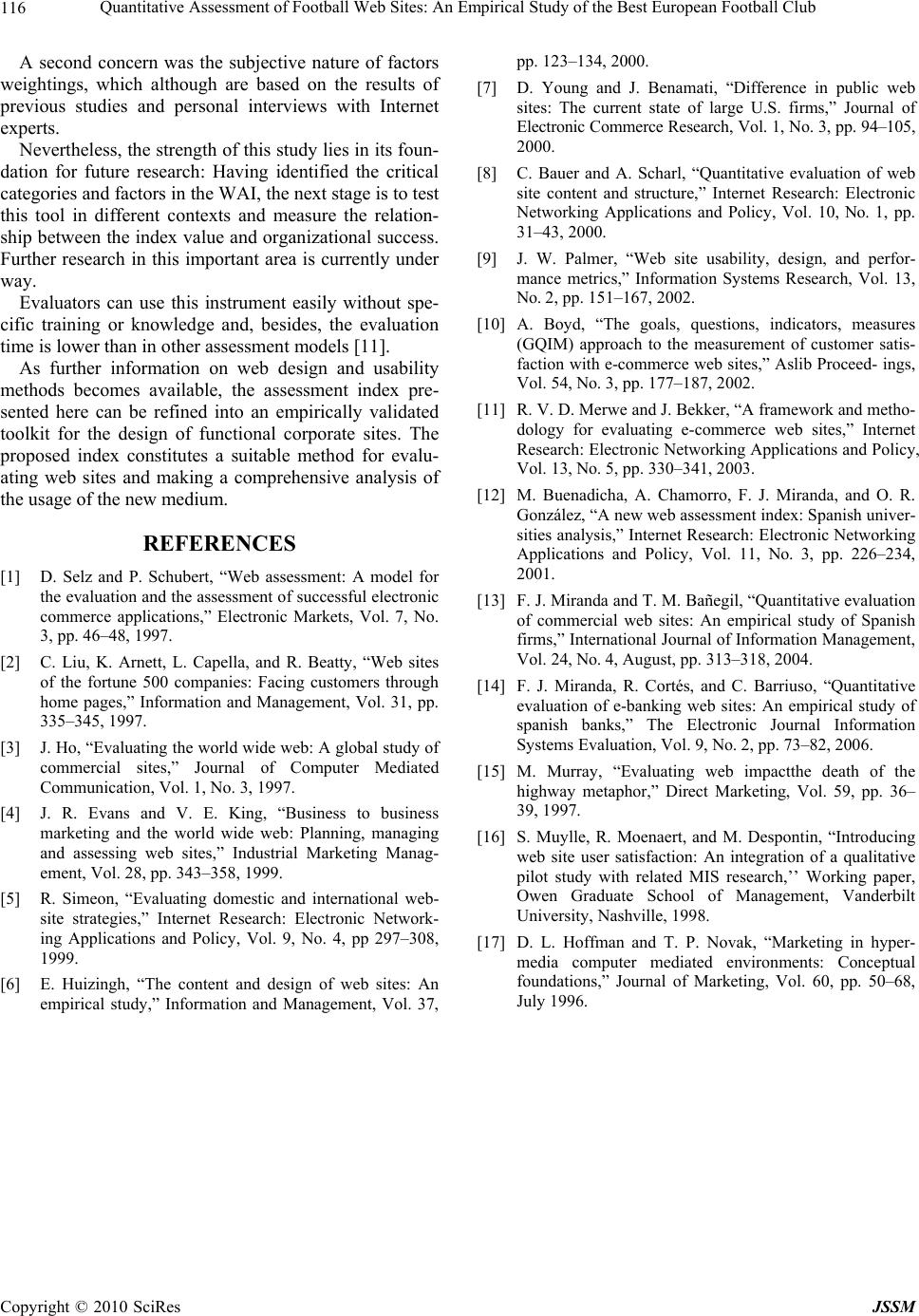 Quantitative Assessment of Football Web Sites: An Empirical Study of the Best European Football Club Copyright © 2010 SciRes JSSM 116 A second concern was the subjective nature of factors weightings, which although are based on the results of previous studies and personal interviews with Internet experts. Nevertheless, the strength of this study lies in its foun- dation for future research: Having identified the critical categories and factors in the WAI, the next stage is to test this tool in different contexts and measure the relation- ship between the index value and organizational success. Further research in this important area is currently under way. Evaluators can use this instrument easily without spe- cific training or knowledge and, besides, the evaluation time is lower than in other assessment models [11]. As further information on web design and usability methods becomes available, the assessment index pre- sented here can be refined into an empirically validated toolkit for the design of functional corporate sites. The proposed index constitutes a suitable method for evalu- ating web sites and making a comprehensive analysis of the usage of the new medium. REFERENCES [1] D. Selz and P. Schubert, “Web assessment: A model for the evaluation and the assessment of successful electronic commerce applications,” Electronic Markets, Vol. 7, No. 3, pp. 46–48, 1997. [2] C. Liu, K. Arnett, L. Capella, and R. Beatty, “Web sites of the fortune 500 companies: Facing customers through home pages,” Information and Management, Vol. 31, pp. 335–345, 1997. [3] J. Ho, “Evaluating the world wide web: A global study of commercial sites,” Journal of Computer Mediated Communication, Vol. 1, No. 3, 1997. [4] J. R. Evans and V. E. King, “Business to business marketing and the world wide web: Planning, managing and assessing web sites,” Industrial Marketing Manag- ement, Vol. 28, pp. 343–358, 1999. [5] R. Simeon, “Evaluating domestic and international web- site strategies,” Internet Research: Electronic Network- ing Applications and Policy, Vol. 9, No. 4, pp 297–308, 1999. [6] E. Huizingh, “The content and design of web sites: An empirical study,” Information and Management, Vol. 37, pp. 123–134, 2000. [7] D. Young and J. Benamati, “Difference in public web sites: The current state of large U.S. firms,” Journal of Electronic Commerce Research, Vol. 1, No. 3, pp. 94–10 5, 2000. [8] C. Bauer and A. Scharl, “Quantitative evaluation of web site content and structure,” Internet Research: Electronic Networking Applications and Policy, Vol. 10, No. 1, pp. 31–43, 2000. [9] J. W. Palmer, “Web site usability, design, and perfor- mance metrics,” Information Systems Research, Vol. 13, No. 2, pp. 151–167, 2002. [10] A. Boyd, “The goals, questions, indicators, measures (GQIM) approach to the measurement of customer satis- faction with e-commerce web sites,” Aslib Proceed- ings, Vol. 54, No. 3, pp. 177–187, 2002. [11] R. V. D. Merwe and J. Bekker, “A framework and metho- dology for evaluating e-commerce web sites,” Internet Research: Electronic Networking Applications and Policy, Vol. 13, No. 5, pp. 330–341, 2003. [12] M. Buenadicha, A. Chamorro, F. J. Miranda, and O. R. González, “A new web assessment index: Spanish univer- sities analysis,” Internet Research: Electronic Networking Applications and Policy, Vol. 11, No. 3, pp. 226–234, 2001. [13] F. J. Miranda and T. M. Bañegil, “Quantitative evaluation of commercial web sites: An empirical study of Spanish firms,” International Journal of Information Management, Vol. 24, No. 4, August, pp. 313–318, 2004. [14] F. J. Miranda, R. Cortés, and C. Barriuso, “Quantitative evaluation of e-banking web sites: An empirical study of spanish banks,” The Electronic Journal Information Systems Evaluation, Vol. 9, No. 2, pp. 73–82, 2006. [15] M. Murray, “Evaluating web impactthe death of the highway metaphor,” Direct Marketing, Vol. 59, pp. 36– 39, 1997. [16] S. Muylle, R. Moenaert, and M. Despontin, “Introducing web site user satisfaction: An integration of a qualitative pilot study with related MIS research,’’ Working paper, Owen Graduate School of Management, Vanderbilt University, Nashville, 1998. [17] D. L. Hoffman and T. P. Novak, “Marketing in hyper- media computer mediated environments: Conceptual foundations,” Journal of Marketing, Vol. 60, pp. 50–68, July 1996. |

